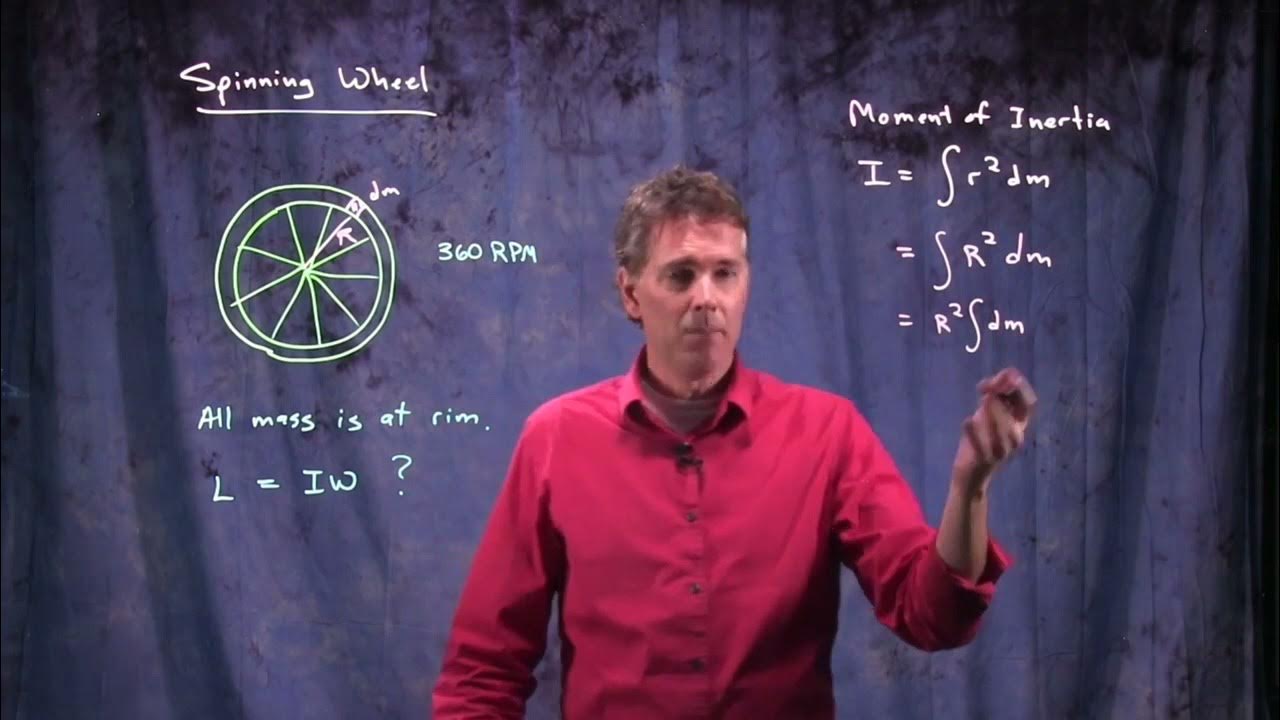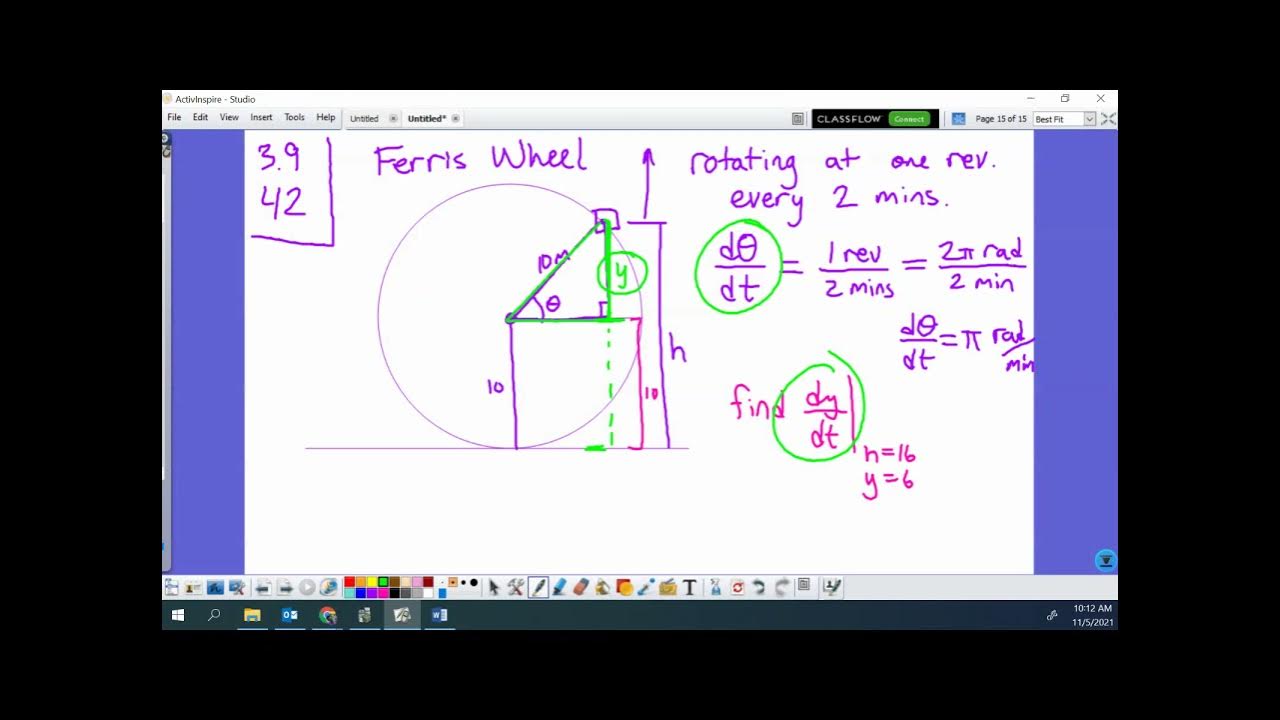Spinning Ice Skater | Physics with Professor Matt Anderson | M12-02
TLDRIn the video script, the presenter explores a physics problem related to an ice skater's spin, using a top view illustration of Brian Boitano as an example. The skater is spinning at a rate of 100 revolutions per minute (rpm), and the task is to calculate the speed of the skater's hands. To do this, the presenter uses the formula v = ω × r, where v is the speed, ω is the angular velocity, and r is the radius of the spin (in this case, the length of the skater's arm). The arm's length is approximated as 70 centimeters. Converting 100 rpm to radians per second, the presenter calculates the angular velocity, then multiplies it by the arm's length in meters to find the hand's speed. The final calculation results in a hand speed of approximately 7.3 meters per second, which is roughly equivalent to 15 miles per hour, providing a relatable and engaging explanation of the physics involved in a spinning skater's motion.
Takeaways
- 🎓 The problem involves calculating the speed of an ice skater's hands while spinning.
- 🧍 The skater is represented by Brian Boitano in the example, with a humorous note about his hands.
- 🌀 The skater's spinning speed is given as 100 revolutions per minute (rpm).
- 🔢 To find the speed, a relationship between velocity (v), angular velocity (omega), and radius (r) is used: v = omega × r.
- ⏱️ The script converts rpm to radians per second, which is necessary for the calculation.
- 📏 The length of the skater's arm is approximated as 70 centimeters for the calculation.
- 📐 One revolution is equivalent to 2π radians, which is used to convert rpm to radians per second.
- 🧮 The calculated angular velocity in radians per second is 100 × 2π / 60.
- 📐 The speed of the hand is then found by multiplying the angular velocity by the length of the arm in meters (0.7 meters).
- 🧮 The approximate speed of the hand is calculated to be around 7.3 meters per second.
- 🚀 This speed is roughly equivalent to 15 miles per hour, which is presented as a reasonable figure.
- 📝 The process involves unit conversion and the application of physics formulas to solve a real-world problem.
Q & A
What is the problem being discussed in the script?
-The problem being discussed is calculating the speed of an ice skater's hands while spinning, using Brian Boitano as an example.
What is the initial spinning speed given for the ice skater?
-The initial spinning speed given is 100 revolutions per minute (rpm).
How is the relationship between speed (v), angular velocity (omega), and radius (r) expressed?
-The relationship is expressed as v = omega * r, where v is the speed, omega is the angular velocity, and r is the radius.
What is the unit conversion needed to calculate the angular velocity in radians per second?
-To convert from rpm to radians per second, you multiply by 2π and divide by 60 seconds.
What is the length of the arm used in the approximation?
-The length of the arm used in the approximation is 70 centimeters.
How is the length of the arm converted for the calculation?
-The length of the arm is converted from centimeters to meters by dividing by 100, resulting in 0.7 meters.
What is the final calculated speed of Brian Boitano's hands in meters per second?
-The final calculated speed of the hands is approximately 7.3 meters per second.
How is the final speed converted to miles per hour?
-The final speed is converted to miles per hour by recognizing that 7.3 meters per second is roughly equivalent to 15 miles per hour.
What is the significance of using SI units in the calculation?
-Using SI units (Système International d'unités) ensures that the units are consistent and standardized, which is crucial for accurate scientific calculations.
Why is it important to cancel out units during the calculation?
-Canceling out units is important to simplify the expression and to ensure that the final answer is in the correct units for the physical quantity being calculated.
What is the role of pi (π) in the calculation of angular velocity?
-Pi (π) is used to convert revolutions to radians since one full revolution is equal to 2π radians.
How does the script demonstrate the application of physics to a real-world scenario?
-The script demonstrates the application of physics by using the principles of circular motion to calculate the speed of a moving object (the ice skater's hands) during spinning.
What is the relevance of this problem to a physics class?
-This problem is relevant to a physics class as it involves the application of concepts like angular velocity, linear speed, and unit conversion, which are fundamental to understanding circular motion.
Outlines
🧊 Calculating the Speed of a Spinning Ice Skater's Hands
The paragraph introduces a physics problem related to an ice skater, specifically focusing on the speed of the skater's hands as they spin. The skater, humorously referred to as having 'ridiculously large hands', is spinning at a rate of 100 revolutions per minute (rpm). To determine the speed of the hands, the length of the skater's arm is approximated to be 70 centimeters. Using the relationship between velocity (v), angular velocity (omega), and radius (r), where v = omega * r, the angular velocity is first converted from rpm to radians per second. The calculation involves multiplying 100 by 2 pi and dividing by 60 to get the angular velocity in radians per second. The speed of the hand is then found by multiplying this angular velocity by the length of the arm in meters (0.7 m). After a quick calculation, the speed is approximated to be around 7.3 meters per second, which is roughly equivalent to 15 miles per hour.
Mindmap
Keywords
💡Ice Skater
💡Spinning
💡Top View
💡Revolutions per Minute (RPM)
💡Speed
💡Radius (r)
💡Angular Velocity (omega)
💡Radian
💡SI Units
💡Linear Speed
💡Miles per Hour (MPH)
Highlights
The problem involves calculating the speed of an ice skater's hands as he spins
The skater is spinning at 100 revolutions per minute (rpm)
The length of the skater's arm is approximated as 70 centimeters
The relationship between speed (v), angular velocity (omega), and radius (r) is v = omega * r
First, convert 100 rpm to radians per second
Multiply by (1 minute/60 seconds) to get rid of the minutes
Multiply by (2 pi radians/1 revolution) to convert revolutions to radians
So omega = (100 * 2 pi) / (60 seconds) = 100 * 2 pi / 60 radians per second
Then the speed of the hand is v = omega * r = (100 * 2 pi / 60) * 0.7 meters
Simplify to get v ≈ 7.2 meters per second
7.2 meters per second is equivalent to roughly 15 miles per hour
The calculation provides a reasonable estimate of the skater's hand speed during a spin
The problem demonstrates the application of physics concepts to a real-world scenario
It shows the relationship between angular velocity and linear speed
Converting units from rpm to radians per second is a key step in the calculation
The skater's arm length is a crucial parameter in determining the hand's speed
The calculation involves basic arithmetic operations and unit conversions
The final answer provides an intuitive understanding of the skater's motion
The problem engages students by using a relevant and interesting example
It helps students appreciate the relevance of physics in everyday life
Transcripts
Browse More Related Video

Angular Momentum of a Spinning Wheel | Physics with Professor Matt Anderson | M12-16

Linear Speed and Angular Velocity

3.9 #42 Related Rates Ferris Wheel Angular Velocity and Right Triangle Trig

Angular Acceleration | Physics

Speed Distance Time | Forces & Motion | Physics | FuseSchool

Rotational Motion - Merry Go Round Slowing Down | Physics with Professor Matt Anderson | M12-03
5.0 / 5 (0 votes)
Thanks for rating: